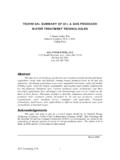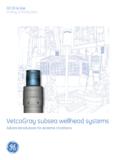Transcription of Technologies Reduce Pad Size, Waste - ALL Consulting
1 By Dan Arthur and Dave CornueTULSA Since the turn of the millen-nium, new onshore oil and gas develop-ment has increasingly focused on uncon-ventional reservoirs such as oil from theBakken Shale of the Williston Basin andnatural gas from numerous shale gasplays ( , Barnett Shale, FayettevilleShale, Haynesville Shale, and MarcellusShale). In some plays, including muchof the Marcellus Shale, this involvesdrilling in areas that have limited experi-ence with oil and gas development. Thishas resulted in increasing levels of publicconcern and in some cases outright re-sistance to resource development.
2 Two topics of concern frequently ex-pressed by regulators, nongovernmentalorganizations, and the public are surfacedisturbance and Waste management. Notsurprisingly, surface disturbance is one ofthe most readily apparent consequencesof resource development. Waste generationis often greater for unconventional reservoirsthan it is for conventional plays, primarilybecause high volume hydraulic fracturing(HVHF), which is typically necessary toeconomically develop low-permeabilityunconventional reservoirs, creates largevolumes of Waste water.
3 This article willexamine a few of the Technologies for ad-dressing these public concerns and reducingenvironmental impacts. The examples dis-cussed will primarily come from shalegas plays, but the basic concepts are ap-plicable to many other unconventional de-velopment scenarios. Modern shale gas development includesboth vertical and horizontal wells. Theemerging shale gas basins are expected tofollow a trend similar to the Barnett Shale,with horizontal wells becoming increasinglycommon as the plays mature. The growingpopularity of horizontal wells stems fromimprovements in technology and the eco-nomic benefits of greater reservoir example, in the Marcellus Shale, avertical well may be exposed to as little as50 feet of the reservoir while a horizontalwell may have a lateral well bore extendingin length from 2,000 to 6,000 feet withinthe target formation.
4 Using horizontal drilling and HVHFon the one hand is a contributor to a keyenvironmental benefit (minimizing surfacedisturbance) and on the other hand is thesource of one of shale development s en-vironmental concerns ( Waste generation). Reducing Surface ImpactsSurface disturbances are part of oiland gas development. The magnitude ofthe disturbance may vary according tothe region or physiographic setting, butsome disturbance is necessary to allowaccess to the resource ( , roads andwell pads) and resource transportationTechnologies Reduce Pad size , WasteFIGURE 1 Footprint of Developing 640 Acres with Vertical WellsThe Better Business Publication Serving the Exploration / drilling / Production IndustryAUGUST 2010 Reproduced for ALL Consulting with permission from The American Oil & Gas ( , pipelines and compressors).
5 To ad-dress this inevitability, oil and gas com-panies have adopted a mantra of avoidingenvironmental impacts when possible,minimizing the impacts that cannot beavoided, and mitigating the impacts thatremain. For example, the companies could de-velop an area of one square mile (640acres) using 16 vertical wells (at 40-acrespacing), each located on a separate wellpad (Figure 1). However, the industryprefers a different approach: using fourto eight horizontal wells drilled from asingle well pad (Figure 2).
6 Using horizontalwells in the Barnett Shale has allowedthree or four vertical wells to be replacedwith a single horizontal well. At full-field development scale, thisreduction in the overall number of wellpads significantly reduces the total envi-ronmental disturbance. The number ofproduction facilities required and totalmileage of access roads and utility corri-dors are reduced, thus minimizing wildlifehabitat fragmentation, impacts on thepublic and overall environmental , horizontal drilling also canmake it possible to develop areas wheresurface occupancy is impractical or performed in 2008 for Department of the Interior, usingthe Fayetteville Shale as an example.
7 Es-timated that a shallow vertical gas welltypically would have a well padplus incremental acres for associatedprocess areas, access roads, utility corridors,etc., resulting in a total construction dis-turbance of acres for each well. Incontrast, a well pad for four or more hor-izontal wells in the same play would oc-cupy only four acres plus incrementalacres for associated process areas, accessroads, utility corridors, etc., resulting in atotal of acres disturbed. Thus, sixteenvertical wells with individual pads androads would disturb 77 acres, more than10 times the area of horizontal wells ca-pable of producing the same natural difference in development footprintis significant in rural and urban Technologies and approaches alsocan limit surface disturbance associatedwith drilling .
8 Advances in drilling tech-nology, such as directional drilling , closed-loop drilling , coiled tubing drilling , modularrigs, pneumatic drilling , slim-hole drilling ,and automated rigs, allow smaller wellpads. In urban settings, steel storage tankscan be used to hold drilling fluids as wellas to store water and fluids for use duringhydraulic fracturing. Tanks used in closed-loop drilling systems decrease the amountof drilling fluids required by facilitatingreuse. This in turn generates less wasteand allows the use of smaller well pads.
9 Fit-for-purpose rigs also can reducedrilling pad size . These specialized rigscan drill multiple horizontal wells effi-ciently from a relatively small well rigs are mounted on a rail system,enabling them to drill one well, then bemoved on the rails several feet to drill thenext. The rig can drill a row of directionalwells from one setup, then the rig andrails can be repositioned to drill a secondrow of directional wells. In fact, some ofthese rigs have rails in two directions toallow drilling two rows of wells withoutFIGURE 2 Footprint of Developing 640 Acres with Horizontal WellsThis low-profile, fit-for-purposedrilling rig is drilling BarnettShale wells at the Dallas-FortWorth airport.
10 SpecialReport: drilling Fluidsbreaking down the rig. In this manner,eight or more wells can be drilled fromone small well pad, shrinking the drillingoperation s footprint while reducing rigmoves and therefore downtime. Such spe-cialized rigs are limited in number andmay not be available in all WasteWaste is generated throughout the de-velopment process, but is perhaps mostprominent during two phases: the drillingphase and the stimulation/completionphase, during which HVHF generateslarge volumes of produced water.









